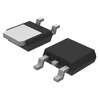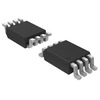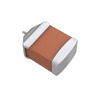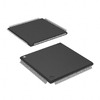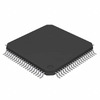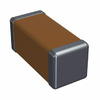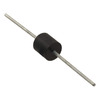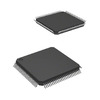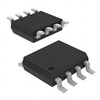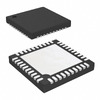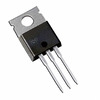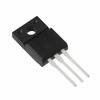PIC16F887 8-bit Microcontroller: Datasheet, Programming, and Specifications
The PIC16F887 microcontroller exemplifies the latest advancement in 8-bit technology, offering a remarkable blend of energy efficiency and versatility thanks to its RISC architecture. This guide aims to explore the PIC16F887 thoroughly, delving into its pin configuration, varied applications, technical specifications, and alternative solutions.Catalog

What is the PIC16F887 Microcontroller?
The PIC16F887 dazzles with its efficient 8-bit RISC architecture, artfully balancing power use to enhance performance. This design shines in scenarios where conserving power fuels the heartbeat, notably in portable and remote tech wonders. Observing the delicate interplay of power efficiency and performance in these devices brings to mind the sweet harmony that can lead to both reliability and delight. An array of packaging choices, including the 40-pin Dual In-line Package (DIP) and surface-mounted types, allows the microcontroller to snugly fit into both tight spaces and expansive electronic landscapes. The PIC16F887 gracefully navigates various communication protocols such as I2C, SPI, and USART, which pulse as the lifeblood of embedded systems in today's electronic era. The microcontroller’s adaptability gleams through its broad application range, touching automotive, electronics, and telecommunications sectors. Its harmonious integration into these fields stems from its sophisticated feature set and robust performance.
Alternatives for PIC16F887
PIC16F877A, PIC16F886, PIC16F84A, PIC18F2550, PIC18F46K22, PIC16F676, PIC16F72, PIC16F873A, PIC16F876A, PIC16F886, PIC18F252, PIC18F2520, PIC18F452, PIC18F4520.
PIC16F887 Pin Configuration

|
Pin Number |
Pin Name |
Description |
|
1 |
MCLR/Vpp/RE3 |
MCLR is used during programming, mostly connected to
programmers like PicKit or 3rd pin of PORTE |
|
2 |
RA0/AN0 |
Analog pin 0 or 0th pin of PORTA |
|
3 |
RA1/AN1 |
Analog pin 1 or 1st pin of PORTA |
|
4 |
RA2/AN2/Vref- |
Analog pin 2 or 2nd pin of PORTA |
|
5 |
RA3/AN3/Vref+ |
Analog pin 3 or 3rd pin of PORTA |
|
6 |
RA4/T0CKI/C1out |
4th pin of PORTA |
|
7 |
RA5/AN4/SS/C2out |
Analog pin 4 or 5th pin of PORTA |
|
8 |
RE0/RD/AN5 |
Analog pin 5 or 0th pin of PORTE |
|
9 |
RE1/WR/AN6 |
Analog pin 6 or 1st pin of PORTE |
|
10 |
RE2/CS/AN7 |
Analog pin 6 or 2nd pin of PORTE |
|
11 |
Vdd |
Ground pin of MCU |
|
12 |
Vss |
Positive pin of MCU (+5V) |
|
13 |
RA7/OSC1/CLKI |
External Oscillator/clock input pin or 7th pin of PORTA |
|
14 |
RA6/OSC2/CLKO |
External Oscillator/clock output pin or 6th pin of PORTA |
|
15 |
RC0/T1OSO/T1CKI |
0th pin of PORT C |
|
16 |
RC1/T1OSI/CCP2 |
1st pin of PORTC or Timer/PWM pin |
|
17 |
RC2/CCP1 |
2nd pin of PORTC or Timer/PWM pin |
|
18 |
RC3/SCK/SCL |
3rd pin of PORTC |
|
19 |
RD0 |
0th pin of PORTD |
|
20 |
RD1 |
1st pin of PORTD |
|
21 |
RD2 |
2nd pin of PORTD |
|
22 |
RD3 |
3rd pin of PORTD |
|
23 |
RC4/SDI/SDA |
4th pin of PORTC or Serial Data in pin |
|
24 |
RC5/SDO |
5th pin of PORTC or Serial Data Out pin |
|
25 |
RC6/Tx/CK |
6th pin of PORTC or Transmitter pin of Microcontroller |
|
26 |
RC7/Rx/DT |
7th pin of PORTC or Receiver pin of Microcontroller |
|
27 |
RD4 |
4th pin of PORTD |
|
28 |
RD5/P1B |
5th pin of PORTD |
|
29 |
RD6/P1C |
6th pin of PORTD |
|
30 |
RD7/P1D |
7th pin of PORTD |
|
31 |
Vss |
Positive pin of MCU (+5V) |
|
32 |
Vdd |
Ground pin of MCU |
|
33 |
RB0/INT |
0th pin of PORTB or External Interrupt pin |
|
34 |
RB1/AN10 |
Analog pin 10 or 1st pin of PORTB |
|
35 |
RB2 /AN8 |
Analog pin 8 or 2nd pin of PORTB |
|
36 |
RB3/PGM/AN9 |
Analog pin 9 or 3rd pin of PORTB or connected to the
programmer |
|
37 |
RB4/AN11 |
Analog pin 11 or 4th pin of PORTB |
|
38 |
RB5/AN13 |
Analog pin 13 or 5th pin of PORTB |
|
39 |
RB6/PGC |
6th pin of PORTB or connected to the programmer |
|
40 |
RB7/PGD |
7th pin of PORTB or connected to the programmer |
PIC16F887 Symbol, Footprint, CAD Model
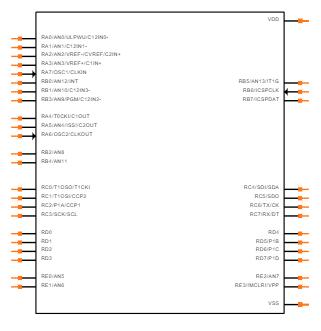
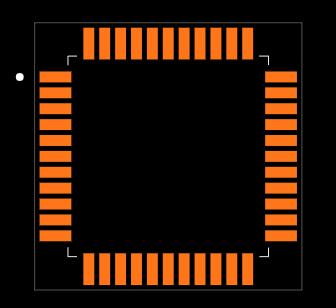
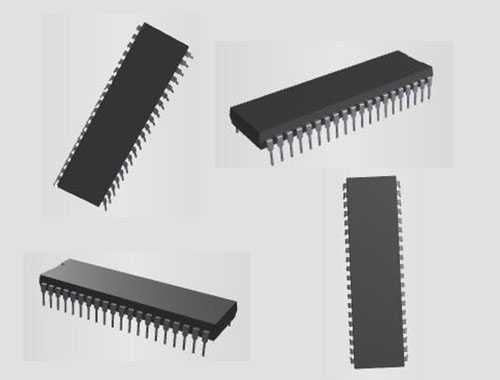
PIC16F887 Technical Specifications
Technical characteristics, features, and parameters of the PIC16F887, along with parts that have comparable specifications to the Microchip Technology PIC16F887-E/P.
|
Type |
Parameter |
|
Factory Lead Time |
6 Weeks |
|
Mounting Type |
Through Hole |
|
Number of Pins |
40 |
|
Number of I/Os |
35 |
|
Operating Temperature |
-40°C~125°C TA |
|
Series |
PIC® 16F |
|
JESD-609 Code |
e3 |
|
Part Status |
Active |
|
Number of Terminations |
40 |
|
Terminal Finish |
Matte Tin (Sn) - annealed |
|
Terminal Position |
DUAL |
|
Frequency |
20MHz |
|
Pin Count |
40 |
|
Supply Voltage-Min (Vsup) |
4.5V |
|
Memory Size |
14kB |
|
RAM Size |
368 x 8 |
|
Mount |
Through Hole |
|
Package / Case |
40-DIP (0.600, 15.24mm) |
|
Data Converters |
A/D 14x10b |
|
Watchdog Timers |
Yes |
|
Packaging |
Tube |
|
Published |
2007 |
|
Pbfree Code |
yes |
|
Moisture Sensitivity Level (MSL) |
1 (Unlimited) |
|
ECCN Code |
EAR99 |
|
Max Power Dissipation |
800mW |
|
Supply Voltage |
5V |
|
Base Part Number |
PIC16F887 |
|
Supply Voltage-Max (Vsup) |
5.5V |
|
Interface |
I2C, SPI, UART, USART |
|
Oscillator Type |
Internal |
|
Voltage - Supply (Vcc/Vdd) |
2V~5.5V |
|
μPs/μCs/Peripheral ICs Type |
MICROCONTROLLER, RISC |
|
Peripherals |
Brown-out Detect/Reset, POR, PWM, WDT |
|
Core Size |
8-Bit |
|
Connectivity |
I2C, SPI, UART/USART |
|
Bit Size |
8 |
|
Has ADC |
YES |
|
Data Bus Width |
8b |
|
Number of Timers/Counters |
3 |
|
CPU Family |
PIC |
|
Number of I2C Channels |
1 |
|
Height |
4.953mm |
|
Width |
14.732mm |
|
Radiation Hardening |
No |
|
Lead Free |
Lead Free |
|
Core Processor |
PIC |
|
Program Memory Type |
FLASH |
|
Program Memory Size |
14KB 8K x 14 |
|
Supply Current-Max |
4.8mA |
|
Access Time |
20 μs |
|
DMA Channels |
NO |
|
PWM Channels |
YES |
|
EEPROM Size |
256 x 8 |
|
Number of ADC Channels |
14 |
|
Number of SPI Channels |
2 |
|
Length |
53.21mm |
|
REACH SVHC |
No SVHC |
|
RoHS Status |
ROHS3 Compliant |
Features of the PIC16F887
CPU Architecture and Oscillators
The PIC16F887 boasts an 8-bit CPU architecture, which facilitates efficient handling of tasks in embedded systems. It incorporates both internal and external oscillators, giving the flexibility to choose a clock source that aligns with their project needs. This dual-oscillator setup enhances adaptability, especially in situations where energy savings or precise timing is desired.
Voltage Range and Energy Efficiency
With an operating voltage range spanning from 2V to 5.5V, the microcontroller offers notable versatility in managing power, making it suitable for both low-power and higher voltage applications. This ability assists in designing portable devices where prolonging battery longevity is required.
GPIO Ports and Peripheral Connectivity
Featuring 36 GPIO ports, the PIC16F887 enables a robust approach to interfacing and control operations. This substantial number of ports supports a wide array of peripheral connections, enhancing configurations for various application needs. Additionally, the provision of two PWM modules and a capture/compare/pulse-width modulation (CCP) module extends its applicability in motor control and other precision-timing applications.
Industry Adoption and Practical Utility
The features of the PIC16F887 have led to its popularity across various industrial domains. Its seamless integration into different systems and the flexibility offered in both power and interfacing make it a preferred choice. Many frequently opt for the PIC16F887 in endeavors requiring a robust yet adaptable microcontroller. Its established success in practical applications strengthens its standing as a core component in modern electronic designs.
Applications of the PIC16F887
Automotive Systems
The PIC16F887’s efficiency in energy consumption offers a compelling solution for automotive systems reliant on battery power. It seamlessly connects with various I/O peripherals, showcasing its adaptability in addressing intricate responsibilities such as engine management and in-depth diagnostic checks. Employing this microcontroller allow you to balance robust performance with energy conservation, fostering dependable long-term functions. Automotive systems often encounter power constraints, where a low-power MCU like the PIC16F887 emerges as a facilitating factor in surmounting these issues.
Industrial Automation
With its extensive input and output capabilities, the PIC16F887 proves versatile across numerous industrial automation tasks. Whether orchestrating the operations of automated machinery or supervising production flows, its flexibility is evident. Integrating the PIC16F887 into industrial settings enhances system cohesion and optimizes overall process effectiveness. Its ADC strength underpins precise data collection, advantageous in quality control and advance maintenance planning.
Consumer Electronics
Within consumer electronics, the demand for efficient energy use and cost-effectiveness is constantly pressing. The PIC16F887 holds its ground, delivering processing power while curbing energy consumption. Utilized in smart gadgets ranging from appliances to portable tech, it empowers devices with smarter energy protocols and improved interfaces, thereby promoting a progressive shift towards sustainable electronics.
Home Appliances
For modern home appliances requiring sophisticated sensing and interaction, the PIC16F887 offers substantial benefits. Its adeptness in ADC allows effective sensor data processing, enabling equipment like washing machines and air conditioners to align with demands and environmental shifts. The impressive feature set of the PIC16F887 in this sector bridges conventional devices with smart home innovations, aligning with the increasing push towards intelligent living spaces.
GPIO Pins in PIC16F877A
The GPIO pins on the PIC16F877A are flexible and can act as either inputs or outputs. When set as inputs, they can use pull-up resistors to help handle different voltage levels smoothly, making it easier to connect with various devices. This flexibility is helpful when working with both older and newer systems that may use different voltage standards.
When setting up GPIOs on the PIC16F877A, keep these points in mind:
• Check if the device you're connecting follows CMOS or TTL voltage standards to avoid compatibility issues and ensure reliable performance.
• Use pull-up resistors to keep digital input signals stable, especially in noisy environments where signals can get distorted.
• For applications that need quick responses, try to balance power efficiency with the output’s drive strength.
• TTL devices may need more power than CMOS devices, so be mindful of current demands. Also, things like temperature and electrical noise can impact how you set up and use GPIO pins.
One of the most powerful aspects of GPIO pins is their potential to inspire creative solutions. With clever design and coding, these simple pins can support advanced features. By designing unique circuits or using smart programming techniques, you can unlock new ways to enhance your device’s capabilities. Tapping into this flexibility can lead to breakthroughs in microcontroller projects. A solid understanding of GPIO features, combined with practical application, can greatly improve your projects with the PIC16F877A microcontroller.
Programming the PIC16F887 Microcontroller
Programming the PIC16F887 microcontroller requires careful setup using the MPLAB X IDE and the XC8 compiler to create precise code. This code is then loaded onto the microcontroller with the PICkit 3, which provides a complete setup for developing and testing directly on the hardware. MPLAB X IDE is an all-in-one tool for developing and testing code. It includes features like simulation and debugging, which help developers work through complex coding challenges more easily. Using tools like watch variables and breakpoints in the IDE lets programmers track how their code is working step-by-step, making it easier to understand and fix issues. The XC8 compiler converts high-level code into machine code that the microcontroller can understand. Adjusting the compiler settings can impact how well the microcontroller performs, and learning to fine-tune these settings comes with practice and experimentation. The PICkit 3 is needed for quickly transferring compiled code to the microcontroller and allowing in-circuit programming, which makes it easy to update firmware.
PIC16F887 Equivalent Components
|
Part Number |
Manufacturer |
Package / Case |
Number of Pins |
Data Bus Width |
Number of I/O |
Interface |
Memory Size |
Supply Voltage |
Peripherals |
|
PIC16F887-E/P |
Microchip Technology |
40-DIP (0.600, 15.24mm) |
40 |
8 b |
35 |
I2C, SPI, UART, USART |
14 kB |
5 V |
Brown-out Detect/Reset, POR, PWM, WDT |
|
PIC16F1517-E/P |
Microchip Technology |
40-DIP (0.600, 15.24mm) |
40 |
8 b |
36 |
I2C, SPI, UART, USART |
14 kB |
3.3 V |
Brown-out Detect/Reset, POR, PWM, WDT |
|
PIC16F707-I/P |
Microchip Technology |
40-DIP (0.600, 15.24mm) |
40 |
8 b |
36 |
I2C, LIN, SPI, UART, USART |
14 kB |
- |
Brown-out Detect/Reset, POR, PWM, WDT |
|
PIC16F1517-I/P |
Microchip Technology |
40-DIP (0.600, 15.24mm) |
40 |
8 b |
36 |
I2C, LIN, SPI, UART, USART |
14 kB |
- |
Brown-out Detect/Reset, POR, PWM, WDT |
PIC16F887 Manufacturer Information
The PIC16F887 microcontroller, a versatile creation of Microchip Technology Inc., stands as a paragon of secure product development, finding its place across myriad global applications. It captivates through its dependable features, adaptability, and the promise of efficiency. Microchip's robust manufacturing ensures that PIC16F887 consistently upholds top-tier quality standards. Rigorous testing processes ensure each unit can endure varied conditions prevalent in assorted applications. These manufacturing precepts mirror industry standards for durability and dependability.
Datasheet PDF
PIC16F1517-I/P Datasheets:
PIC16(L)F1516-19 Datasheet.pdf
PIC16(L)F151x,152x Programming Spec.pdf
Label and Packing Changes 23/Sep/2015.pdf
Packing Changes 10/Oct/2016.pdf
About us
ALLELCO LIMITED
Read more
Quick inquiry
Please send an inquiry, we will respond immediately.
Frequently Asked Questions [FAQ]
1. How much program memory is on the PIC16F887?
The PIC16F887 accommodates a program memory size of 14KB, offering substantial room for sophisticated program storage. This considerable capacity becomes instrumental when executing intricate code, particularly in scenarios demanding advanced algorithms and comprehensive data processing.
2. Which port in PIC 16f887 has four pins?
The PIC16F887 is designed with a dual set of ground pins and power input pins, creating an integrated structure within the circuit. This careful design bolsters power stability, a quality esteemed by dealing with fluctuating power environments, as it diminishes the chance of operational disruptions.
3. How many input output pins are there in PIC16F887?
The PIC16F887 boasts 33 I/O pins among its total 40 pins, offering a wide array of interfacing options. The variety it provides is beneficial in projects demanding extensive data interaction, like sensor networks and control architectures. The forward-thinking use of these I/O capabilities often leads to innovative design solutions.
4. How many IO ports are there in PIC16F877A?
Comprising five distinct ports, PortA, PortB, PortC, PortD, and PortE, the PIC16F877A supplies unique channels for data and signal management, streamlining communication within complex systems. Others frequently exploit these ports to refine their designs, leveraging the wide adaptability the microcontroller presents.
5. How many analog pins are in PIC16F877A?
Equipped with eight analog input pins alongside a 10-bit Analog to Digital Converter (ADC), this microcontroller supports exacting analog signal processing. Such capabilities are use for applications like data acquisition and monitoring, where enhanced system precision and steadfast performance are often realized through these features.
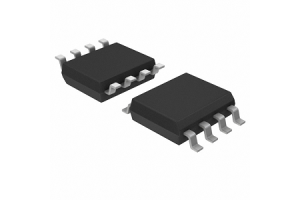
LM393D Comparator: Features, Specifications, and Datasheet
on November 11th

NRF24L01 Transceiver: Pinout, Equivalents, and Datasheet
on November 11th
Popular Posts
-

What is GND in the circuit?
on January 1th 3149
-

RJ-45 Connector Guide: RJ-45 Connector Color Codes, Wiring Schemes, R-J45 Applications, RJ-45 Datasheets
on January 1th 2705
-

Understanding Power Supply Voltages in Electronics VCC, VDD, VEE, VSS, and GND
on November 16th 2285
-

Fiber Connector Types: SC Vs LC And LC Vs MTP
on January 1th 2195
-

Comparison Between DB9 and RS232
on January 1th 1813
-

What Is An LR44 Battery?
Electricity, that ubiquitous force, quietly permeates every aspect of our daily lives, from trivial gadgets to life-threatening medical equipment, it plays a silent role. However, truly grasping this energy, especially how to store and efficiently output it, is no easy task. It is against this background that this article will focus on a type of coin cell battery that may seem insignificant on the...on January 1th 1785
-

Understanding the Fundamentals:Inductance Resistance, andCapacitance
In the intricate dance of electrical engineering, a trio of fundamental elements takes center stage: inductance, resistance, and capacitance. Each bears unique traits that dictate the dynamic rhythms of electronic circuits. Here, we embark on a journey to decipher the complexities of these components, to uncover their distinct roles and practical uses within the vast electrical orchestra. Inductan...on January 1th 1737
-

CR2430 Battery Comprehensive Guide: Specifications, Applications and Comparison to CR2032 Batteries
What is CR2430 battery ?Benefits of CR2430 BatteriesNormCR2430 Battery ApplicationsCR2430 EquivalentCR2430 VS CR2032Battery CR2430 SizeWhat to look for when buying the CR2430 and equivalentsData Sheet PDFFrequently Asked Questions Batteries are the heart of small electronic devices. Among the many types available, coin cells play a crucial role, commonly found in calculators, remote controls, and ...on January 1th 1699
-

What Is RF and Why Do We Use It?
Radio Frequency (RF) technology is a key part of modern wireless communication, enabling data transmission over long distances without physical connections. This article delves into the basics of RF, explaining how electromagnetic radiation (EMR) makes RF communication possible. We will explore the principles of EMR, the creation and control of RF signals, and their wide-ranging uses. The article ...on January 1th 1692
-

Comprehensive guide to hFE in transistors
Transistors are crucial components in modern electronic devices, enabling signal amplification and control. This article delves into the knowledge surrounding hFE, including how to select a transistor's hFE value, how to find hFE, and the gain of different types of transistors. Through our exploration of hFE, we gain a deeper understanding of how transistors work and their role in electronic circu...on November 16th 1660







